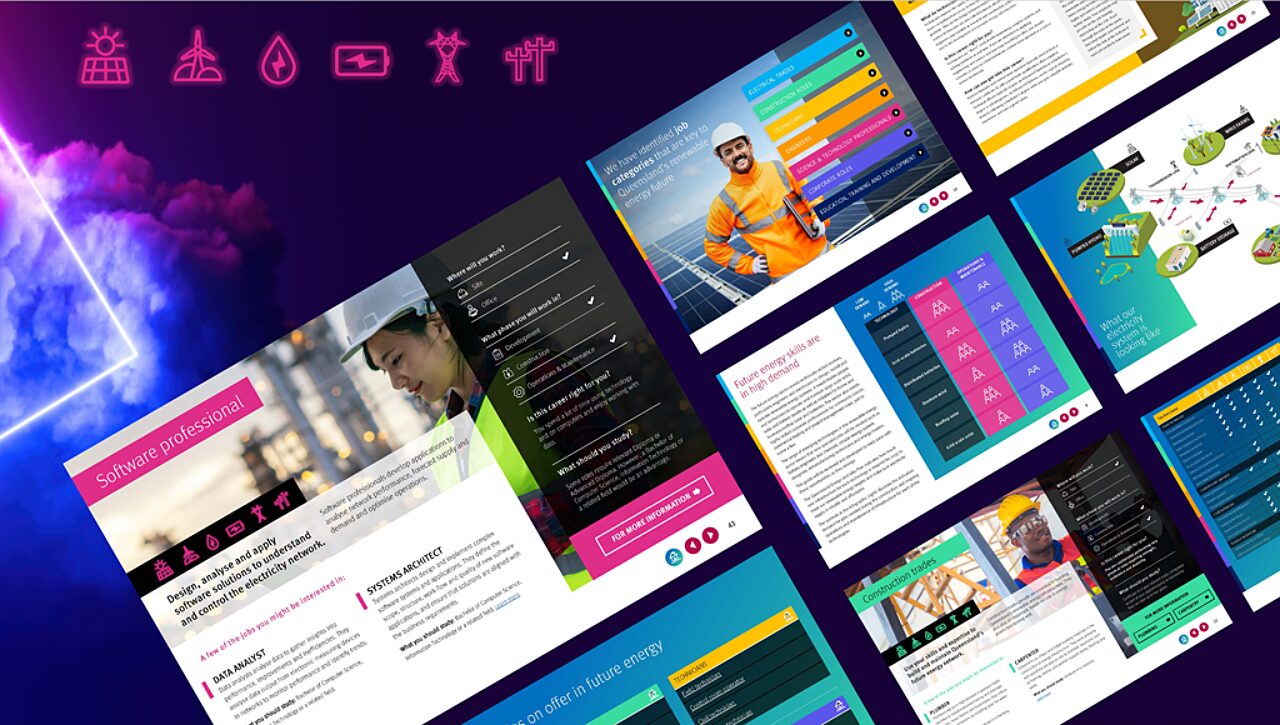Our client was the Queensland Department of Employment, Small Business and Training.
The energy transition will require a skilled workforce
By 2035, 80 per cent of Queensland’s electricity will come from renewable sources. The impact on jobs will be huge.
This transition will require more skilled people working to install solar panels and wind turbines, construct pumped hydro facilities, and upgrade the transmission and distribution networks. In fact, the Queensland Government is supporting up to 100,000 direct and indirect jobs through the Queensland Energy and Jobs Plan, most in regional communities.
To make this transition a success, it is essential that there is a future workforce with the right skills and in the right places. The transition will need many skilled workers in fields including electrical trades, engineering, construction and science.
To support a skilled and ready clean energy workforce the Queensland Government developed Queensland's Clean Energy Workforce Roadmap, delivering 37 actions to support the development of the clean energy workforce.
To complement the Roadmap, the Queensland Government wanted to assist students, as well as jobseekers and other people already in the workforce, to understand the opportunities in the energy sector.
We worked with the Department of Employment, Small Business and Training to develop the Future Energy Jobs Guide: an information source putting detail on future energy career opportunities, and the pathways to get there, at people’s fingertips.
The Jobs Guide needed to be more than just a reliable source of information – it needed to excite and inspire students to embark on a career in which they can make a difference, and to help them to understand how flexible jobs in future energy are, both in what people can study and what work they can do.
The guide brought together many sources of information
To be most useful, the guide needed to be informed by people close to the energy transition.
We consulted closely with stakeholders including government-owned corporations, industry skills advisers and bodies, education and training providers, and unions. With each group we took the time to understand their view on future skill needs, then collaborated with them on drafts to ensure we properly reflected their inputs. This consultation was supplemented with our data analysis of ANZCO job codes to ensure there were no overlaps or gaps.
Given a key target audience of the guide would be school leavers, we worked with the Queensland Department of Education and other government departments.
The resulting jobs guide offers an overview of the sector, the phases of a project when job demand will be highest, and comments from leading voices in the sector.
It then details occupations across the spectrum of renewable energy – including generation, transmission, distribution and storage – and across the project lifecycle – from design to planning and approvals, finance, construction, operations and maintenance.
For each job, it explains what is involved, the skills required, the pathways to get there, and links for further information. We also offer a helpful series of pictograms to allow users to learn more at a glance.
The guide was written in an accessible way by our communications specialists and designed for maximum impact by our visual design studio.


School leavers and workers are using the guide
The Queensland Government released the Future Energy Jobs Guide in October 2023.
This guide is now helping school leavers and existing workers to envision themselves in an energy career that will contribute to a lower-emission energy future.
It is being supported by the Queensland Government, which is investing more than $1.3 billion annually in skills and training to deliver high-quality training and creating exciting career pathways for Queenslanders.
What you can learn from this project
Guidance needs to be informed by experts in the sector who know the current state of play and can anticipate the future.
The language and visual design need to be clear and accessible so that people from a wide array of backgrounds can take in the information.
When it comes to career options, people need high-level information about the sector coupled with specific detail about future job opportunities.





